NUR1201: Reflective Essay: Patient Experience and Partnering in Care
VerifiedAdded on 2022/10/06
|9
|2223
|58
Essay
AI Summary
This reflective essay analyzes a case study of an elderly patient, William Taylor, and his experiences within the Australian healthcare system, focusing on areas for improvement in nursing care. Using Gibb's reflective model, the essay explores issues of trust, communication, and person-centered care. The essay highlights the patient's negative experiences, including long wait times, lack of communication, and a perceived lack of care, particularly regarding falls and his experience with kidney stones. The essay delves into the importance of ethical nursing practices, values, and effective communication in building patient trust and improving health outcomes. The author suggests the implementation of team-nursing and the Orlando's nursing process to enhance person-centric care and communication. The essay concludes by emphasizing the need for a more patient-centered approach, improved communication, and partnership with patients to improve the overall nursing care and healthcare systems. The essay also references the role of e-health records in relation to partnering in care, and the importance of preventing falls and harm from falls.
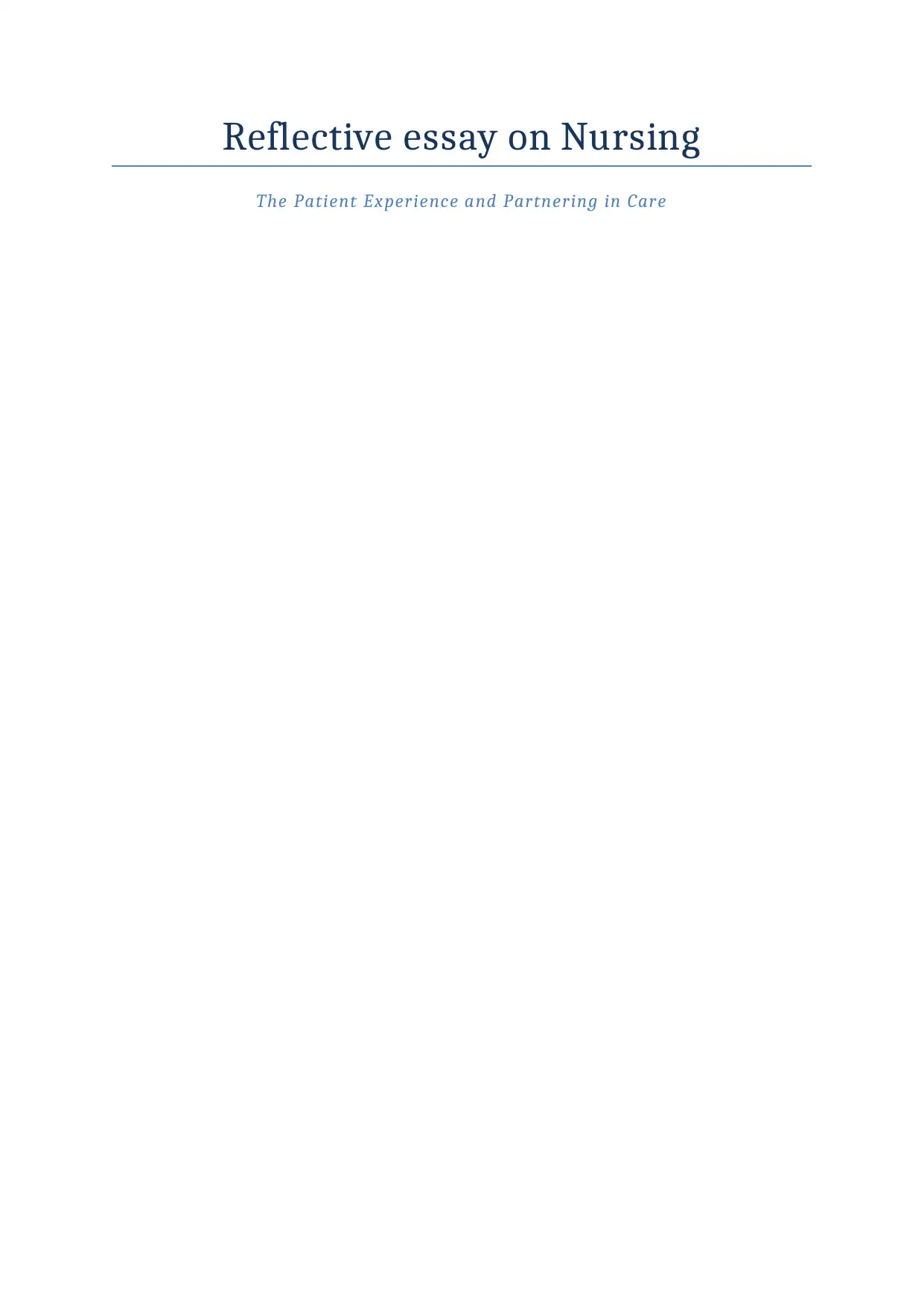
Reflective essay on Nursing
The Patient Experience and Partnering in Care
The Patient Experience and Partnering in Care
Paraphrase This Document
Need a fresh take? Get an instant paraphrase of this document with our AI Paraphraser
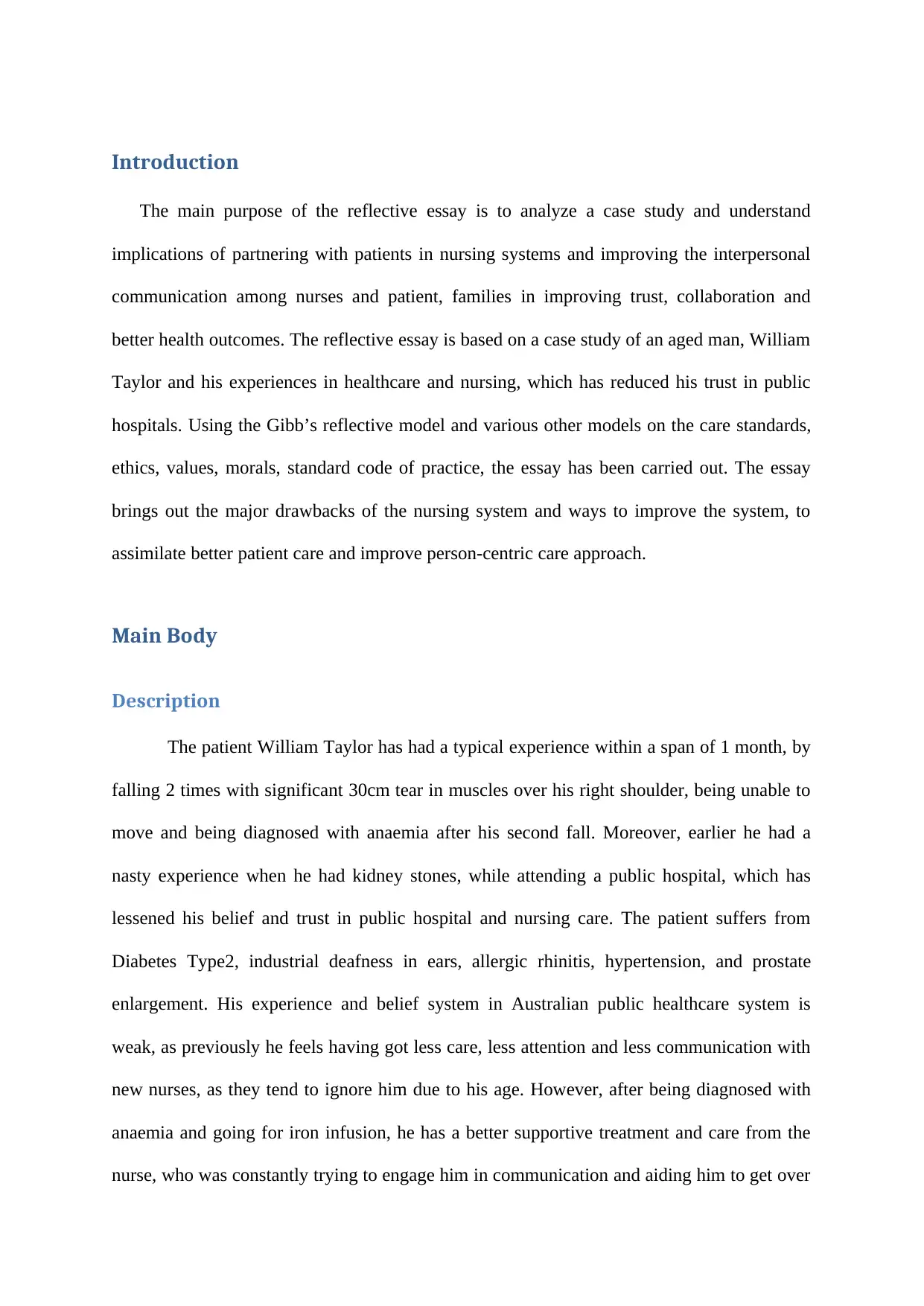
Introduction
The main purpose of the reflective essay is to analyze a case study and understand
implications of partnering with patients in nursing systems and improving the interpersonal
communication among nurses and patient, families in improving trust, collaboration and
better health outcomes. The reflective essay is based on a case study of an aged man, William
Taylor and his experiences in healthcare and nursing, which has reduced his trust in public
hospitals. Using the Gibb’s reflective model and various other models on the care standards,
ethics, values, morals, standard code of practice, the essay has been carried out. The essay
brings out the major drawbacks of the nursing system and ways to improve the system, to
assimilate better patient care and improve person-centric care approach.
Main Body
Description
The patient William Taylor has had a typical experience within a span of 1 month, by
falling 2 times with significant 30cm tear in muscles over his right shoulder, being unable to
move and being diagnosed with anaemia after his second fall. Moreover, earlier he had a
nasty experience when he had kidney stones, while attending a public hospital, which has
lessened his belief and trust in public hospital and nursing care. The patient suffers from
Diabetes Type2, industrial deafness in ears, allergic rhinitis, hypertension, and prostate
enlargement. His experience and belief system in Australian public healthcare system is
weak, as previously he feels having got less care, less attention and less communication with
new nurses, as they tend to ignore him due to his age. However, after being diagnosed with
anaemia and going for iron infusion, he has a better supportive treatment and care from the
nurse, who was constantly trying to engage him in communication and aiding him to get over
The main purpose of the reflective essay is to analyze a case study and understand
implications of partnering with patients in nursing systems and improving the interpersonal
communication among nurses and patient, families in improving trust, collaboration and
better health outcomes. The reflective essay is based on a case study of an aged man, William
Taylor and his experiences in healthcare and nursing, which has reduced his trust in public
hospitals. Using the Gibb’s reflective model and various other models on the care standards,
ethics, values, morals, standard code of practice, the essay has been carried out. The essay
brings out the major drawbacks of the nursing system and ways to improve the system, to
assimilate better patient care and improve person-centric care approach.
Main Body
Description
The patient William Taylor has had a typical experience within a span of 1 month, by
falling 2 times with significant 30cm tear in muscles over his right shoulder, being unable to
move and being diagnosed with anaemia after his second fall. Moreover, earlier he had a
nasty experience when he had kidney stones, while attending a public hospital, which has
lessened his belief and trust in public hospital and nursing care. The patient suffers from
Diabetes Type2, industrial deafness in ears, allergic rhinitis, hypertension, and prostate
enlargement. His experience and belief system in Australian public healthcare system is
weak, as previously he feels having got less care, less attention and less communication with
new nurses, as they tend to ignore him due to his age. However, after being diagnosed with
anaemia and going for iron infusion, he has a better supportive treatment and care from the
nurse, who was constantly trying to engage him in communication and aiding him to get over
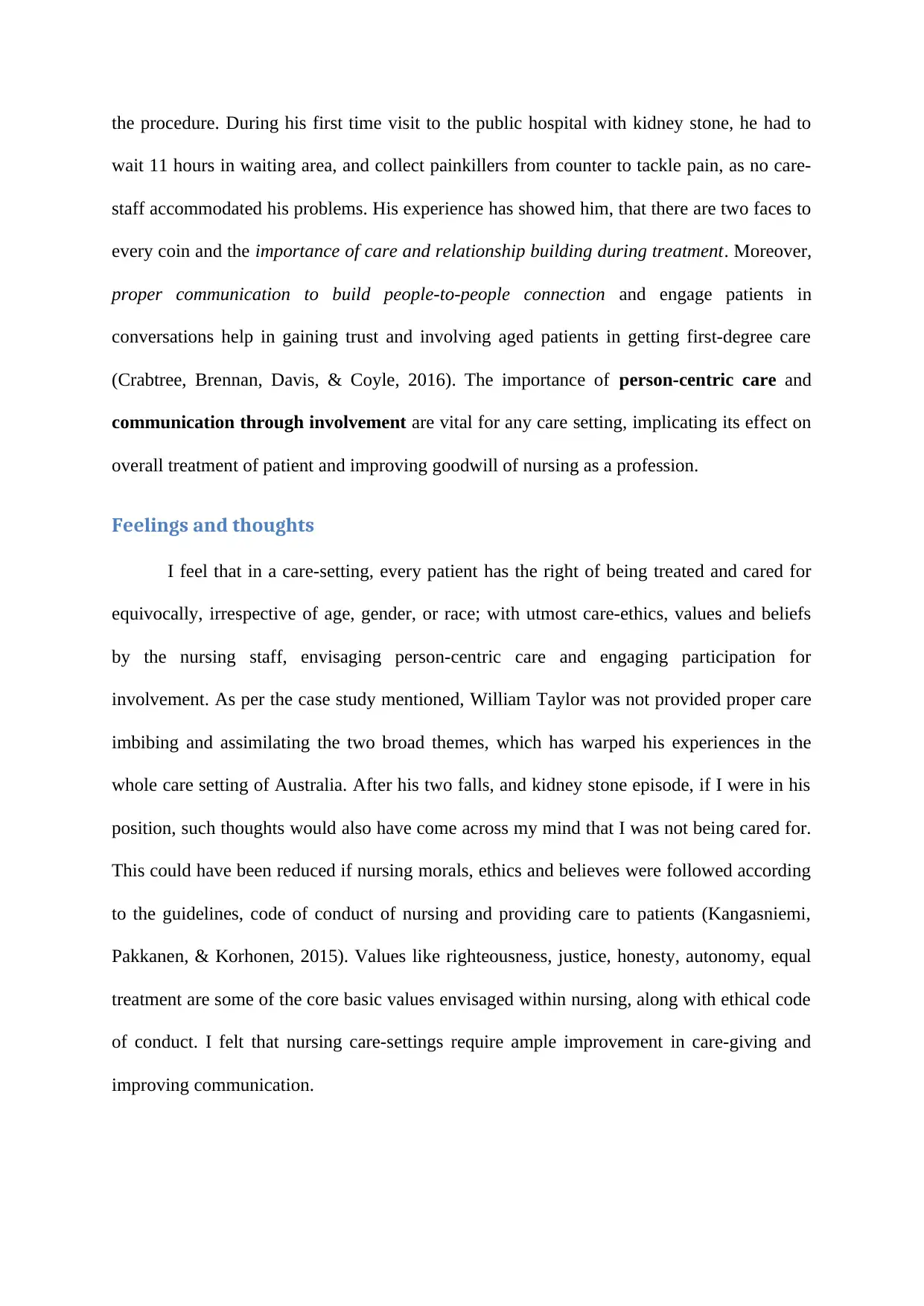
the procedure. During his first time visit to the public hospital with kidney stone, he had to
wait 11 hours in waiting area, and collect painkillers from counter to tackle pain, as no care-
staff accommodated his problems. His experience has showed him, that there are two faces to
every coin and the importance of care and relationship building during treatment. Moreover,
proper communication to build people-to-people connection and engage patients in
conversations help in gaining trust and involving aged patients in getting first-degree care
(Crabtree, Brennan, Davis, & Coyle, 2016). The importance of person-centric care and
communication through involvement are vital for any care setting, implicating its effect on
overall treatment of patient and improving goodwill of nursing as a profession.
Feelings and thoughts
I feel that in a care-setting, every patient has the right of being treated and cared for
equivocally, irrespective of age, gender, or race; with utmost care-ethics, values and beliefs
by the nursing staff, envisaging person-centric care and engaging participation for
involvement. As per the case study mentioned, William Taylor was not provided proper care
imbibing and assimilating the two broad themes, which has warped his experiences in the
whole care setting of Australia. After his two falls, and kidney stone episode, if I were in his
position, such thoughts would also have come across my mind that I was not being cared for.
This could have been reduced if nursing morals, ethics and believes were followed according
to the guidelines, code of conduct of nursing and providing care to patients (Kangasniemi,
Pakkanen, & Korhonen, 2015). Values like righteousness, justice, honesty, autonomy, equal
treatment are some of the core basic values envisaged within nursing, along with ethical code
of conduct. I felt that nursing care-settings require ample improvement in care-giving and
improving communication.
wait 11 hours in waiting area, and collect painkillers from counter to tackle pain, as no care-
staff accommodated his problems. His experience has showed him, that there are two faces to
every coin and the importance of care and relationship building during treatment. Moreover,
proper communication to build people-to-people connection and engage patients in
conversations help in gaining trust and involving aged patients in getting first-degree care
(Crabtree, Brennan, Davis, & Coyle, 2016). The importance of person-centric care and
communication through involvement are vital for any care setting, implicating its effect on
overall treatment of patient and improving goodwill of nursing as a profession.
Feelings and thoughts
I feel that in a care-setting, every patient has the right of being treated and cared for
equivocally, irrespective of age, gender, or race; with utmost care-ethics, values and beliefs
by the nursing staff, envisaging person-centric care and engaging participation for
involvement. As per the case study mentioned, William Taylor was not provided proper care
imbibing and assimilating the two broad themes, which has warped his experiences in the
whole care setting of Australia. After his two falls, and kidney stone episode, if I were in his
position, such thoughts would also have come across my mind that I was not being cared for.
This could have been reduced if nursing morals, ethics and believes were followed according
to the guidelines, code of conduct of nursing and providing care to patients (Kangasniemi,
Pakkanen, & Korhonen, 2015). Values like righteousness, justice, honesty, autonomy, equal
treatment are some of the core basic values envisaged within nursing, along with ethical code
of conduct. I felt that nursing care-settings require ample improvement in care-giving and
improving communication.
⊘ This is a preview!⊘
Do you want full access?
Subscribe today to unlock all pages.

Trusted by 1+ million students worldwide
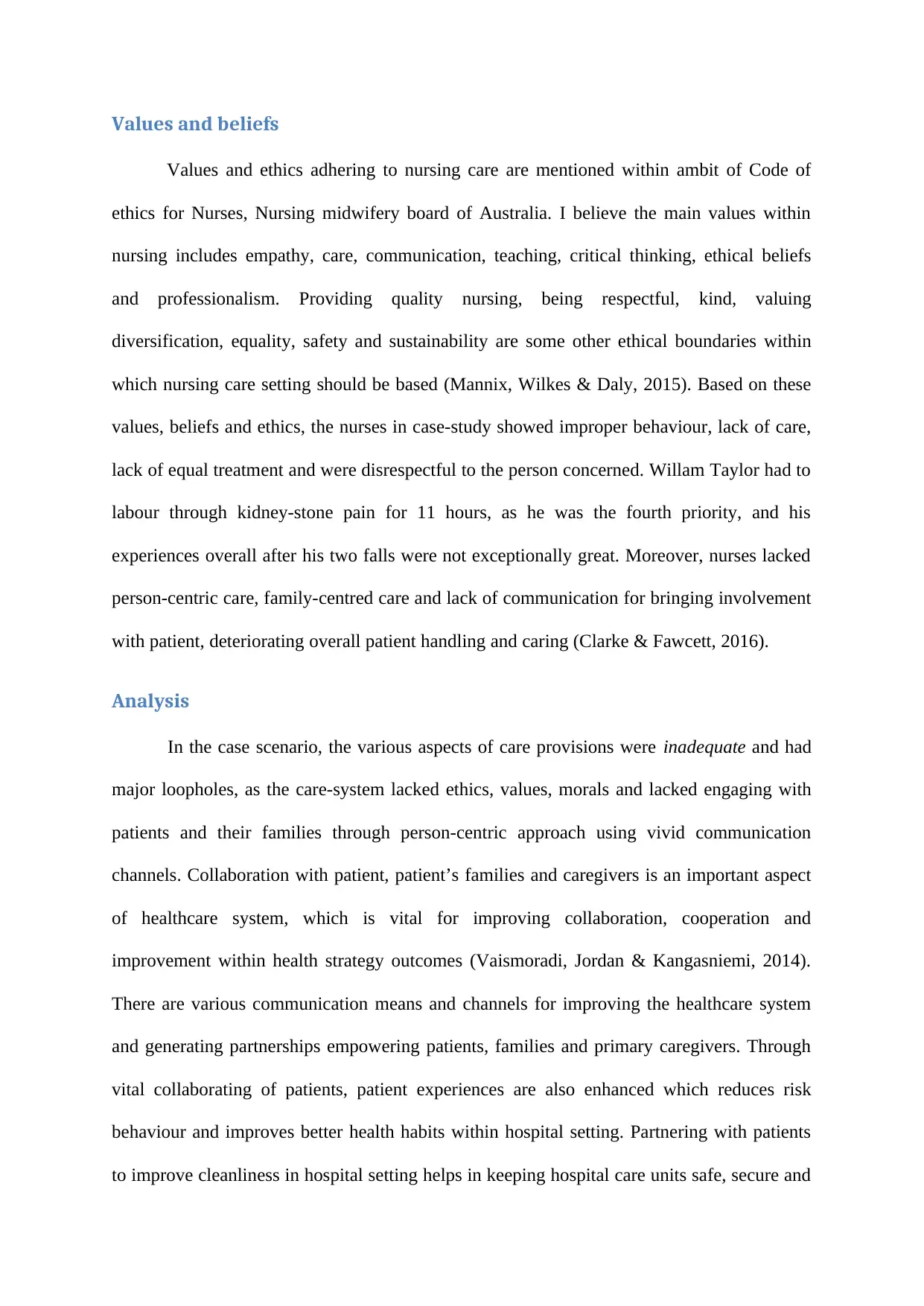
Values and beliefs
Values and ethics adhering to nursing care are mentioned within ambit of Code of
ethics for Nurses, Nursing midwifery board of Australia. I believe the main values within
nursing includes empathy, care, communication, teaching, critical thinking, ethical beliefs
and professionalism. Providing quality nursing, being respectful, kind, valuing
diversification, equality, safety and sustainability are some other ethical boundaries within
which nursing care setting should be based (Mannix, Wilkes & Daly, 2015). Based on these
values, beliefs and ethics, the nurses in case-study showed improper behaviour, lack of care,
lack of equal treatment and were disrespectful to the person concerned. Willam Taylor had to
labour through kidney-stone pain for 11 hours, as he was the fourth priority, and his
experiences overall after his two falls were not exceptionally great. Moreover, nurses lacked
person-centric care, family-centred care and lack of communication for bringing involvement
with patient, deteriorating overall patient handling and caring (Clarke & Fawcett, 2016).
Analysis
In the case scenario, the various aspects of care provisions were inadequate and had
major loopholes, as the care-system lacked ethics, values, morals and lacked engaging with
patients and their families through person-centric approach using vivid communication
channels. Collaboration with patient, patient’s families and caregivers is an important aspect
of healthcare system, which is vital for improving collaboration, cooperation and
improvement within health strategy outcomes (Vaismoradi, Jordan & Kangasniemi, 2014).
There are various communication means and channels for improving the healthcare system
and generating partnerships empowering patients, families and primary caregivers. Through
vital collaborating of patients, patient experiences are also enhanced which reduces risk
behaviour and improves better health habits within hospital setting. Partnering with patients
to improve cleanliness in hospital setting helps in keeping hospital care units safe, secure and
Values and ethics adhering to nursing care are mentioned within ambit of Code of
ethics for Nurses, Nursing midwifery board of Australia. I believe the main values within
nursing includes empathy, care, communication, teaching, critical thinking, ethical beliefs
and professionalism. Providing quality nursing, being respectful, kind, valuing
diversification, equality, safety and sustainability are some other ethical boundaries within
which nursing care setting should be based (Mannix, Wilkes & Daly, 2015). Based on these
values, beliefs and ethics, the nurses in case-study showed improper behaviour, lack of care,
lack of equal treatment and were disrespectful to the person concerned. Willam Taylor had to
labour through kidney-stone pain for 11 hours, as he was the fourth priority, and his
experiences overall after his two falls were not exceptionally great. Moreover, nurses lacked
person-centric care, family-centred care and lack of communication for bringing involvement
with patient, deteriorating overall patient handling and caring (Clarke & Fawcett, 2016).
Analysis
In the case scenario, the various aspects of care provisions were inadequate and had
major loopholes, as the care-system lacked ethics, values, morals and lacked engaging with
patients and their families through person-centric approach using vivid communication
channels. Collaboration with patient, patient’s families and caregivers is an important aspect
of healthcare system, which is vital for improving collaboration, cooperation and
improvement within health strategy outcomes (Vaismoradi, Jordan & Kangasniemi, 2014).
There are various communication means and channels for improving the healthcare system
and generating partnerships empowering patients, families and primary caregivers. Through
vital collaborating of patients, patient experiences are also enhanced which reduces risk
behaviour and improves better health habits within hospital setting. Partnering with patients
to improve cleanliness in hospital setting helps in keeping hospital care units safe, secure and
Paraphrase This Document
Need a fresh take? Get an instant paraphrase of this document with our AI Paraphraser
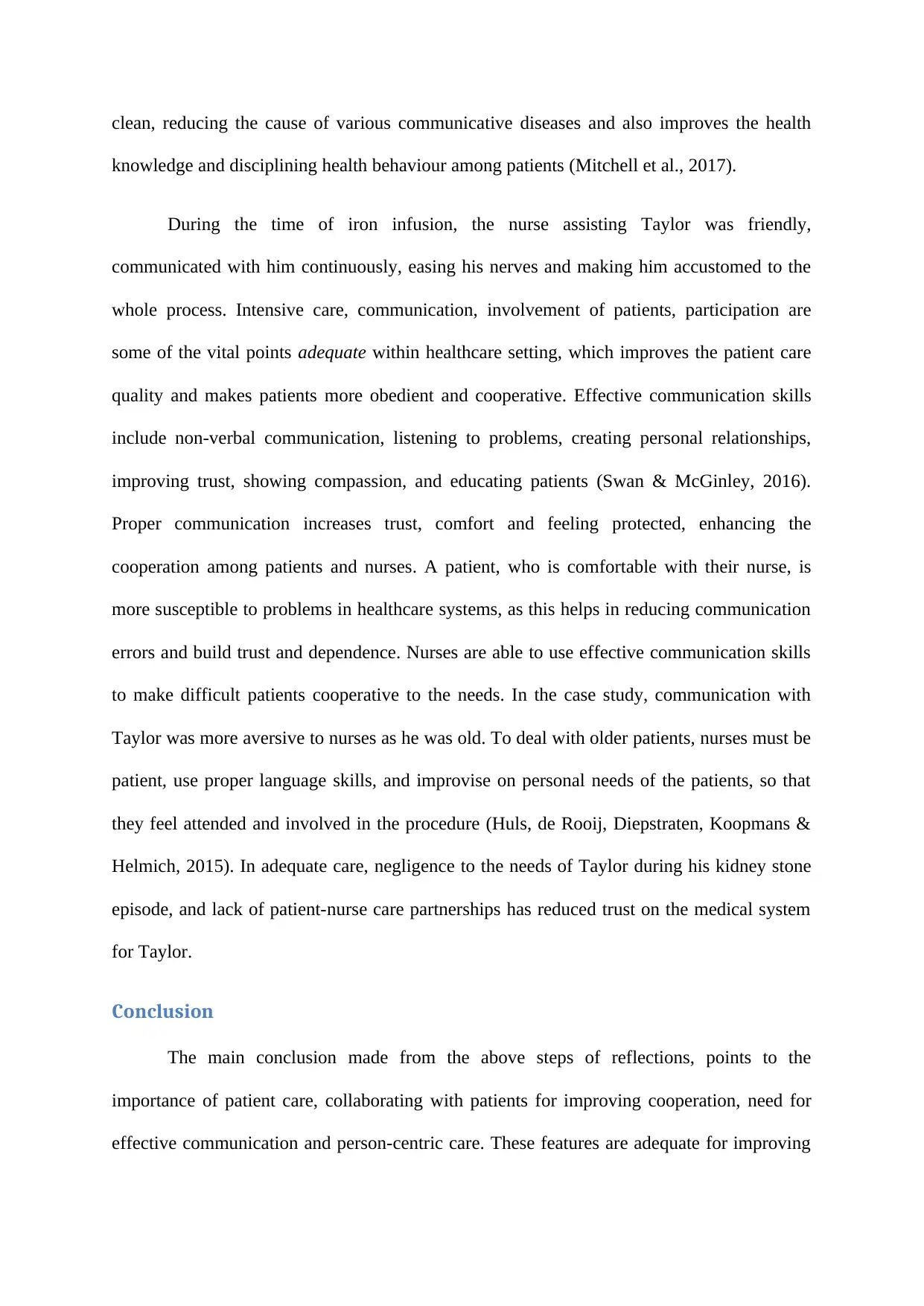
clean, reducing the cause of various communicative diseases and also improves the health
knowledge and disciplining health behaviour among patients (Mitchell et al., 2017).
During the time of iron infusion, the nurse assisting Taylor was friendly,
communicated with him continuously, easing his nerves and making him accustomed to the
whole process. Intensive care, communication, involvement of patients, participation are
some of the vital points adequate within healthcare setting, which improves the patient care
quality and makes patients more obedient and cooperative. Effective communication skills
include non-verbal communication, listening to problems, creating personal relationships,
improving trust, showing compassion, and educating patients (Swan & McGinley, 2016).
Proper communication increases trust, comfort and feeling protected, enhancing the
cooperation among patients and nurses. A patient, who is comfortable with their nurse, is
more susceptible to problems in healthcare systems, as this helps in reducing communication
errors and build trust and dependence. Nurses are able to use effective communication skills
to make difficult patients cooperative to the needs. In the case study, communication with
Taylor was more aversive to nurses as he was old. To deal with older patients, nurses must be
patient, use proper language skills, and improvise on personal needs of the patients, so that
they feel attended and involved in the procedure (Huls, de Rooij, Diepstraten, Koopmans &
Helmich, 2015). In adequate care, negligence to the needs of Taylor during his kidney stone
episode, and lack of patient-nurse care partnerships has reduced trust on the medical system
for Taylor.
Conclusion
The main conclusion made from the above steps of reflections, points to the
importance of patient care, collaborating with patients for improving cooperation, need for
effective communication and person-centric care. These features are adequate for improving
knowledge and disciplining health behaviour among patients (Mitchell et al., 2017).
During the time of iron infusion, the nurse assisting Taylor was friendly,
communicated with him continuously, easing his nerves and making him accustomed to the
whole process. Intensive care, communication, involvement of patients, participation are
some of the vital points adequate within healthcare setting, which improves the patient care
quality and makes patients more obedient and cooperative. Effective communication skills
include non-verbal communication, listening to problems, creating personal relationships,
improving trust, showing compassion, and educating patients (Swan & McGinley, 2016).
Proper communication increases trust, comfort and feeling protected, enhancing the
cooperation among patients and nurses. A patient, who is comfortable with their nurse, is
more susceptible to problems in healthcare systems, as this helps in reducing communication
errors and build trust and dependence. Nurses are able to use effective communication skills
to make difficult patients cooperative to the needs. In the case study, communication with
Taylor was more aversive to nurses as he was old. To deal with older patients, nurses must be
patient, use proper language skills, and improvise on personal needs of the patients, so that
they feel attended and involved in the procedure (Huls, de Rooij, Diepstraten, Koopmans &
Helmich, 2015). In adequate care, negligence to the needs of Taylor during his kidney stone
episode, and lack of patient-nurse care partnerships has reduced trust on the medical system
for Taylor.
Conclusion
The main conclusion made from the above steps of reflections, points to the
importance of patient care, collaborating with patients for improving cooperation, need for
effective communication and person-centric care. These features are adequate for improving
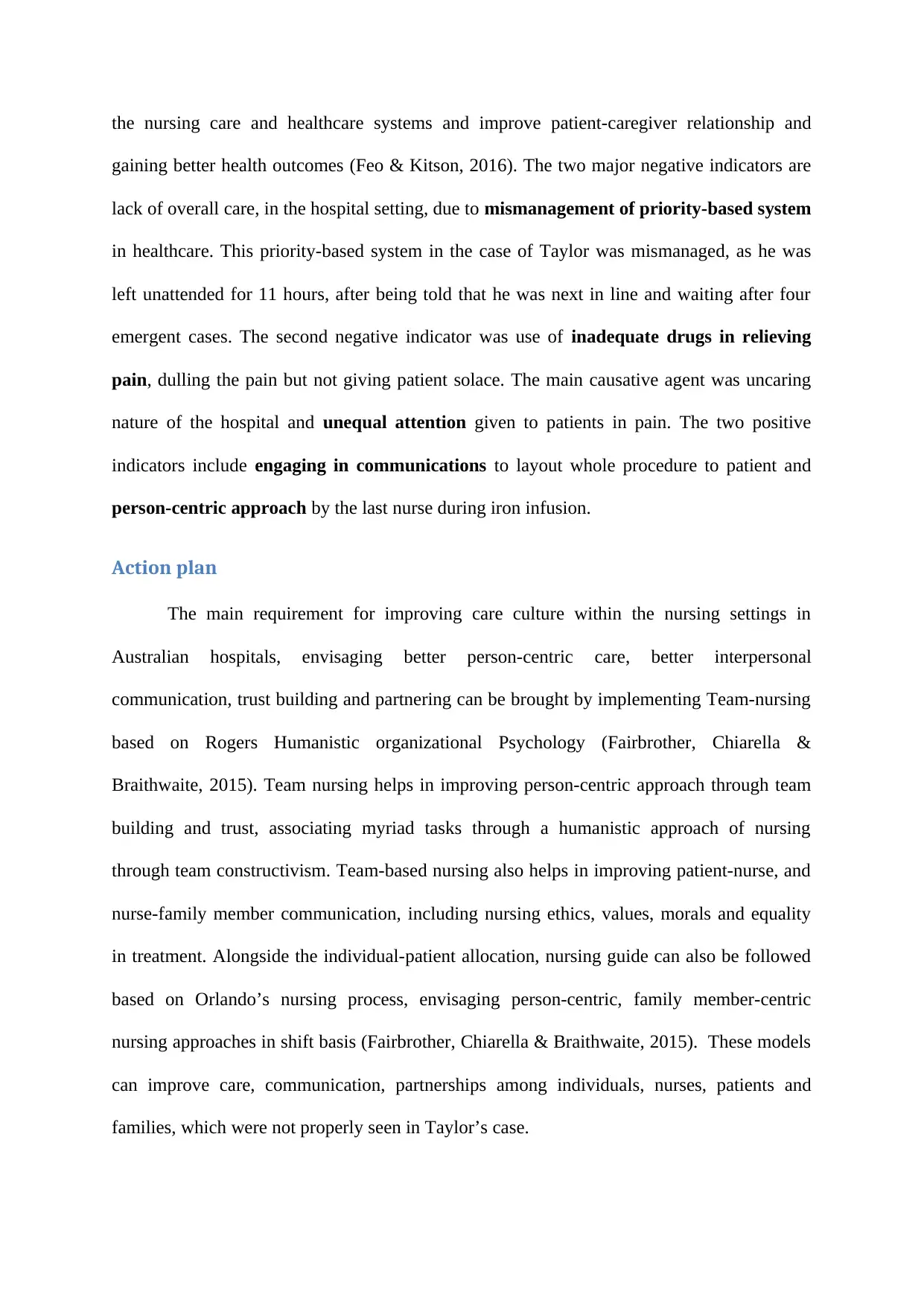
the nursing care and healthcare systems and improve patient-caregiver relationship and
gaining better health outcomes (Feo & Kitson, 2016). The two major negative indicators are
lack of overall care, in the hospital setting, due to mismanagement of priority-based system
in healthcare. This priority-based system in the case of Taylor was mismanaged, as he was
left unattended for 11 hours, after being told that he was next in line and waiting after four
emergent cases. The second negative indicator was use of inadequate drugs in relieving
pain, dulling the pain but not giving patient solace. The main causative agent was uncaring
nature of the hospital and unequal attention given to patients in pain. The two positive
indicators include engaging in communications to layout whole procedure to patient and
person-centric approach by the last nurse during iron infusion.
Action plan
The main requirement for improving care culture within the nursing settings in
Australian hospitals, envisaging better person-centric care, better interpersonal
communication, trust building and partnering can be brought by implementing Team-nursing
based on Rogers Humanistic organizational Psychology (Fairbrother, Chiarella &
Braithwaite, 2015). Team nursing helps in improving person-centric approach through team
building and trust, associating myriad tasks through a humanistic approach of nursing
through team constructivism. Team-based nursing also helps in improving patient-nurse, and
nurse-family member communication, including nursing ethics, values, morals and equality
in treatment. Alongside the individual-patient allocation, nursing guide can also be followed
based on Orlando’s nursing process, envisaging person-centric, family member-centric
nursing approaches in shift basis (Fairbrother, Chiarella & Braithwaite, 2015). These models
can improve care, communication, partnerships among individuals, nurses, patients and
families, which were not properly seen in Taylor’s case.
gaining better health outcomes (Feo & Kitson, 2016). The two major negative indicators are
lack of overall care, in the hospital setting, due to mismanagement of priority-based system
in healthcare. This priority-based system in the case of Taylor was mismanaged, as he was
left unattended for 11 hours, after being told that he was next in line and waiting after four
emergent cases. The second negative indicator was use of inadequate drugs in relieving
pain, dulling the pain but not giving patient solace. The main causative agent was uncaring
nature of the hospital and unequal attention given to patients in pain. The two positive
indicators include engaging in communications to layout whole procedure to patient and
person-centric approach by the last nurse during iron infusion.
Action plan
The main requirement for improving care culture within the nursing settings in
Australian hospitals, envisaging better person-centric care, better interpersonal
communication, trust building and partnering can be brought by implementing Team-nursing
based on Rogers Humanistic organizational Psychology (Fairbrother, Chiarella &
Braithwaite, 2015). Team nursing helps in improving person-centric approach through team
building and trust, associating myriad tasks through a humanistic approach of nursing
through team constructivism. Team-based nursing also helps in improving patient-nurse, and
nurse-family member communication, including nursing ethics, values, morals and equality
in treatment. Alongside the individual-patient allocation, nursing guide can also be followed
based on Orlando’s nursing process, envisaging person-centric, family member-centric
nursing approaches in shift basis (Fairbrother, Chiarella & Braithwaite, 2015). These models
can improve care, communication, partnerships among individuals, nurses, patients and
families, which were not properly seen in Taylor’s case.
⊘ This is a preview!⊘
Do you want full access?
Subscribe today to unlock all pages.

Trusted by 1+ million students worldwide
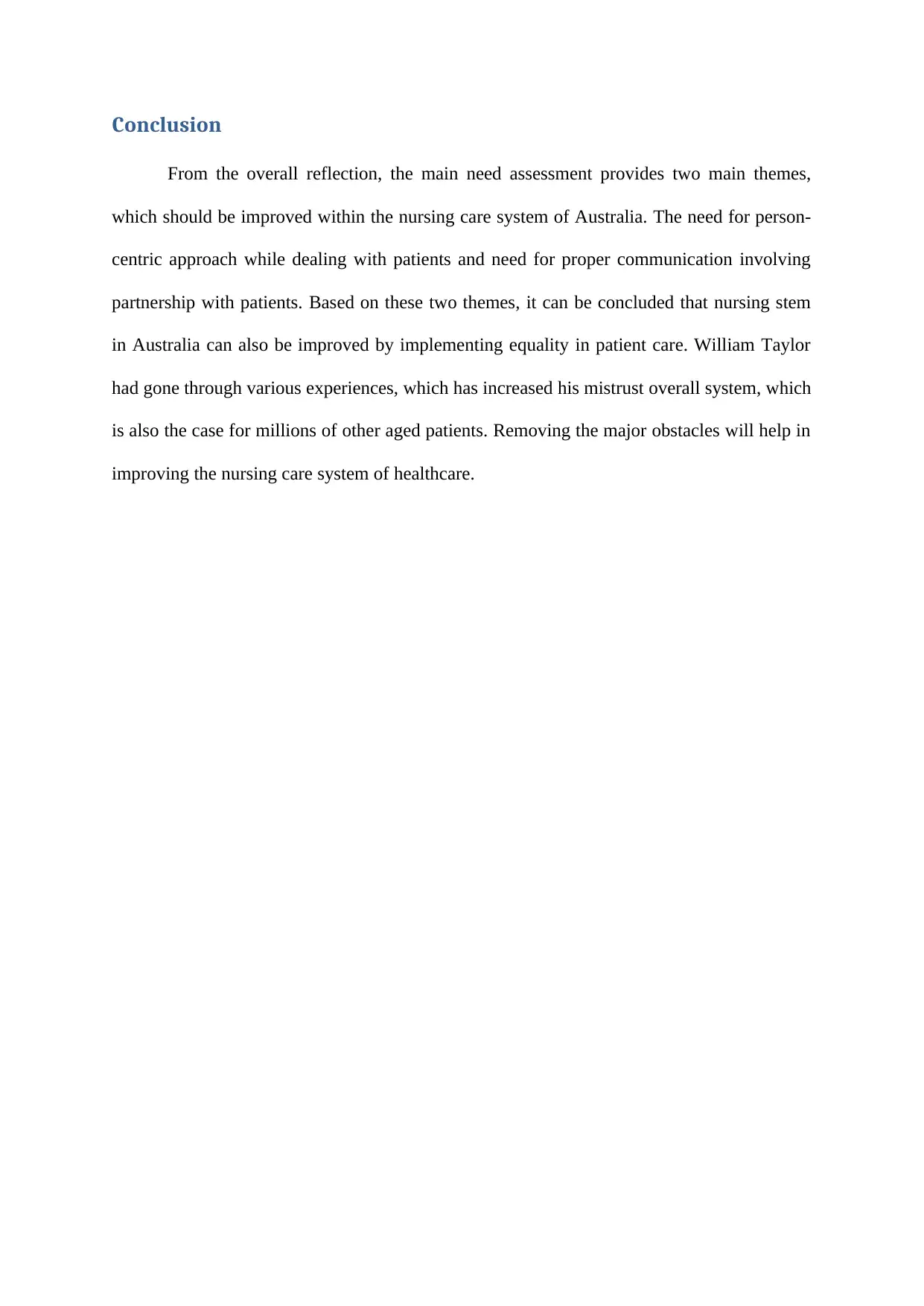
Conclusion
From the overall reflection, the main need assessment provides two main themes,
which should be improved within the nursing care system of Australia. The need for person-
centric approach while dealing with patients and need for proper communication involving
partnership with patients. Based on these two themes, it can be concluded that nursing stem
in Australia can also be improved by implementing equality in patient care. William Taylor
had gone through various experiences, which has increased his mistrust overall system, which
is also the case for millions of other aged patients. Removing the major obstacles will help in
improving the nursing care system of healthcare.
From the overall reflection, the main need assessment provides two main themes,
which should be improved within the nursing care system of Australia. The need for person-
centric approach while dealing with patients and need for proper communication involving
partnership with patients. Based on these two themes, it can be concluded that nursing stem
in Australia can also be improved by implementing equality in patient care. William Taylor
had gone through various experiences, which has increased his mistrust overall system, which
is also the case for millions of other aged patients. Removing the major obstacles will help in
improving the nursing care system of healthcare.
Paraphrase This Document
Need a fresh take? Get an instant paraphrase of this document with our AI Paraphraser
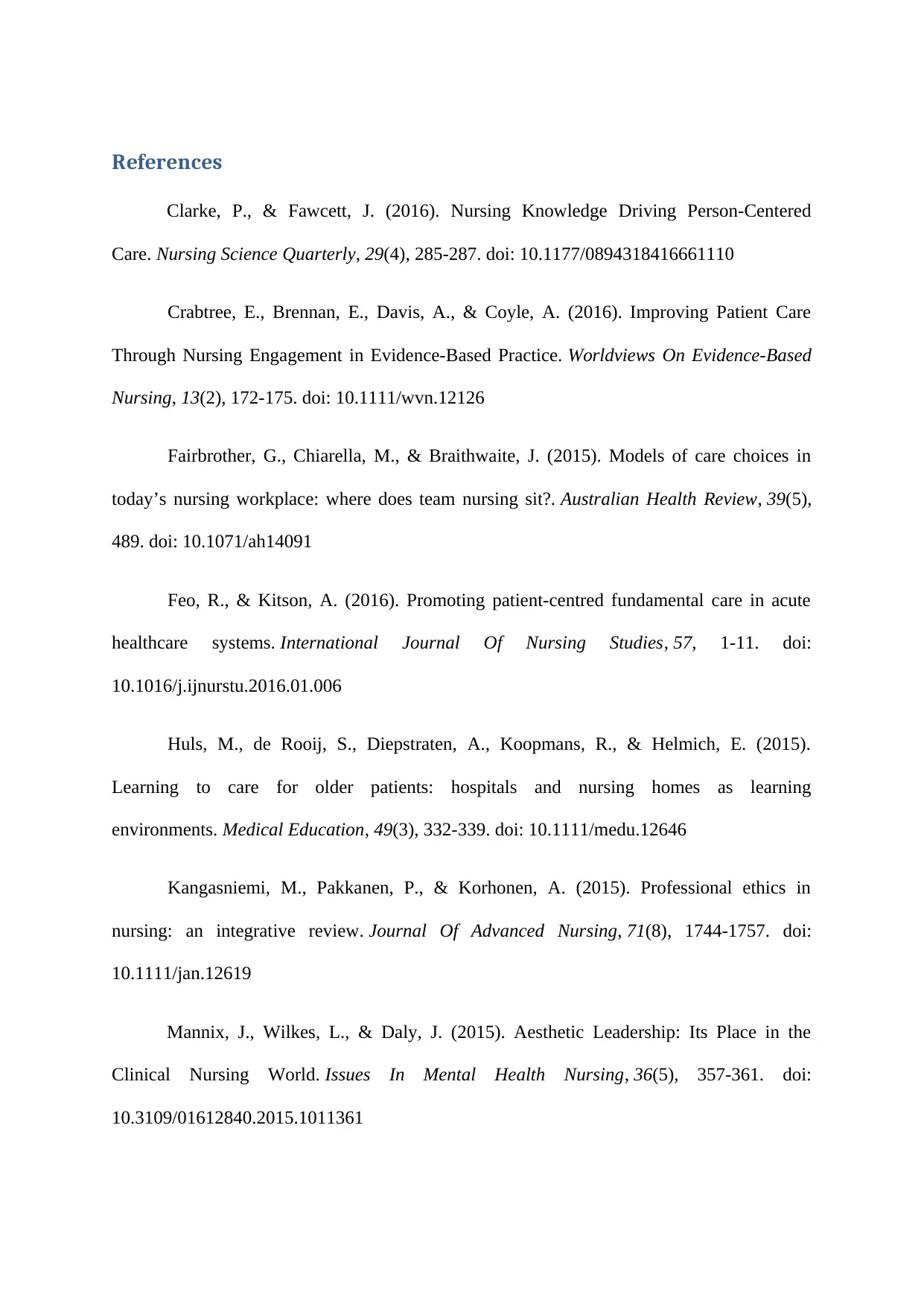
References
Clarke, P., & Fawcett, J. (2016). Nursing Knowledge Driving Person-Centered
Care. Nursing Science Quarterly, 29(4), 285-287. doi: 10.1177/0894318416661110
Crabtree, E., Brennan, E., Davis, A., & Coyle, A. (2016). Improving Patient Care
Through Nursing Engagement in Evidence-Based Practice. Worldviews On Evidence-Based
Nursing, 13(2), 172-175. doi: 10.1111/wvn.12126
Fairbrother, G., Chiarella, M., & Braithwaite, J. (2015). Models of care choices in
today’s nursing workplace: where does team nursing sit?. Australian Health Review, 39(5),
489. doi: 10.1071/ah14091
Feo, R., & Kitson, A. (2016). Promoting patient-centred fundamental care in acute
healthcare systems. International Journal Of Nursing Studies, 57, 1-11. doi:
10.1016/j.ijnurstu.2016.01.006
Huls, M., de Rooij, S., Diepstraten, A., Koopmans, R., & Helmich, E. (2015).
Learning to care for older patients: hospitals and nursing homes as learning
environments. Medical Education, 49(3), 332-339. doi: 10.1111/medu.12646
Kangasniemi, M., Pakkanen, P., & Korhonen, A. (2015). Professional ethics in
nursing: an integrative review. Journal Of Advanced Nursing, 71(8), 1744-1757. doi:
10.1111/jan.12619
Mannix, J., Wilkes, L., & Daly, J. (2015). Aesthetic Leadership: Its Place in the
Clinical Nursing World. Issues In Mental Health Nursing, 36(5), 357-361. doi:
10.3109/01612840.2015.1011361
Clarke, P., & Fawcett, J. (2016). Nursing Knowledge Driving Person-Centered
Care. Nursing Science Quarterly, 29(4), 285-287. doi: 10.1177/0894318416661110
Crabtree, E., Brennan, E., Davis, A., & Coyle, A. (2016). Improving Patient Care
Through Nursing Engagement in Evidence-Based Practice. Worldviews On Evidence-Based
Nursing, 13(2), 172-175. doi: 10.1111/wvn.12126
Fairbrother, G., Chiarella, M., & Braithwaite, J. (2015). Models of care choices in
today’s nursing workplace: where does team nursing sit?. Australian Health Review, 39(5),
489. doi: 10.1071/ah14091
Feo, R., & Kitson, A. (2016). Promoting patient-centred fundamental care in acute
healthcare systems. International Journal Of Nursing Studies, 57, 1-11. doi:
10.1016/j.ijnurstu.2016.01.006
Huls, M., de Rooij, S., Diepstraten, A., Koopmans, R., & Helmich, E. (2015).
Learning to care for older patients: hospitals and nursing homes as learning
environments. Medical Education, 49(3), 332-339. doi: 10.1111/medu.12646
Kangasniemi, M., Pakkanen, P., & Korhonen, A. (2015). Professional ethics in
nursing: an integrative review. Journal Of Advanced Nursing, 71(8), 1744-1757. doi:
10.1111/jan.12619
Mannix, J., Wilkes, L., & Daly, J. (2015). Aesthetic Leadership: Its Place in the
Clinical Nursing World. Issues In Mental Health Nursing, 36(5), 357-361. doi:
10.3109/01612840.2015.1011361
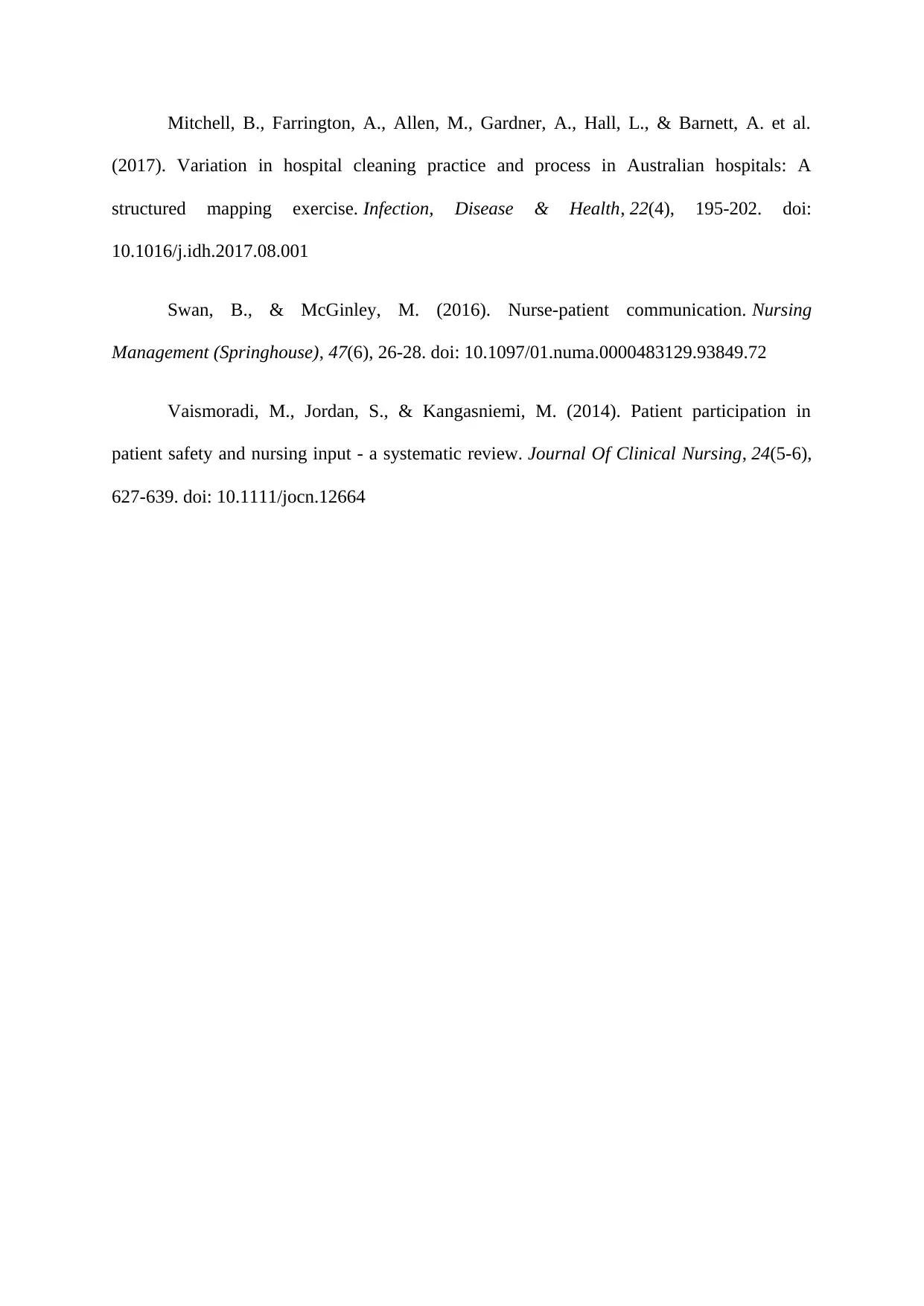
Mitchell, B., Farrington, A., Allen, M., Gardner, A., Hall, L., & Barnett, A. et al.
(2017). Variation in hospital cleaning practice and process in Australian hospitals: A
structured mapping exercise. Infection, Disease & Health, 22(4), 195-202. doi:
10.1016/j.idh.2017.08.001
Swan, B., & McGinley, M. (2016). Nurse-patient communication. Nursing
Management (Springhouse), 47(6), 26-28. doi: 10.1097/01.numa.0000483129.93849.72
Vaismoradi, M., Jordan, S., & Kangasniemi, M. (2014). Patient participation in
patient safety and nursing input - a systematic review. Journal Of Clinical Nursing, 24(5-6),
627-639. doi: 10.1111/jocn.12664
(2017). Variation in hospital cleaning practice and process in Australian hospitals: A
structured mapping exercise. Infection, Disease & Health, 22(4), 195-202. doi:
10.1016/j.idh.2017.08.001
Swan, B., & McGinley, M. (2016). Nurse-patient communication. Nursing
Management (Springhouse), 47(6), 26-28. doi: 10.1097/01.numa.0000483129.93849.72
Vaismoradi, M., Jordan, S., & Kangasniemi, M. (2014). Patient participation in
patient safety and nursing input - a systematic review. Journal Of Clinical Nursing, 24(5-6),
627-639. doi: 10.1111/jocn.12664
⊘ This is a preview!⊘
Do you want full access?
Subscribe today to unlock all pages.

Trusted by 1+ million students worldwide
1 out of 9
Related Documents
Your All-in-One AI-Powered Toolkit for Academic Success.
+13062052269
info@desklib.com
Available 24*7 on WhatsApp / Email
![[object Object]](/_next/static/media/star-bottom.7253800d.svg)
Unlock your academic potential
Copyright © 2020–2025 A2Z Services. All Rights Reserved. Developed and managed by ZUCOL.





